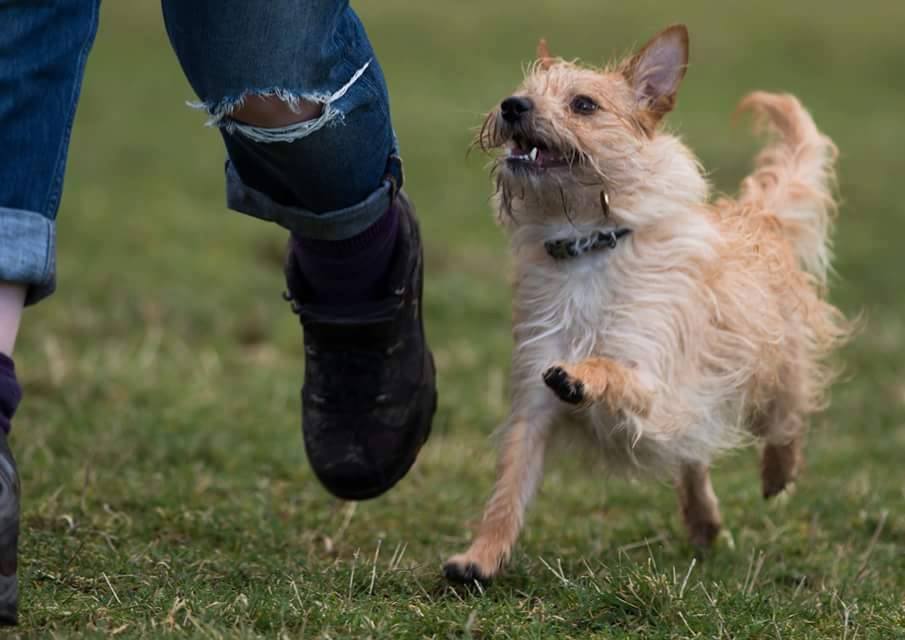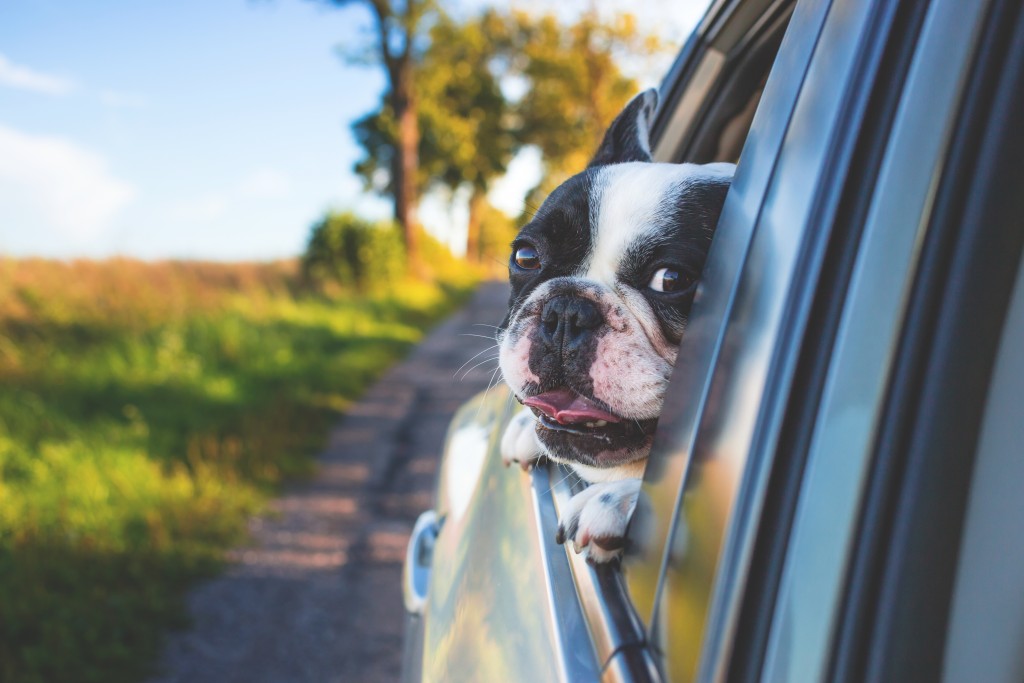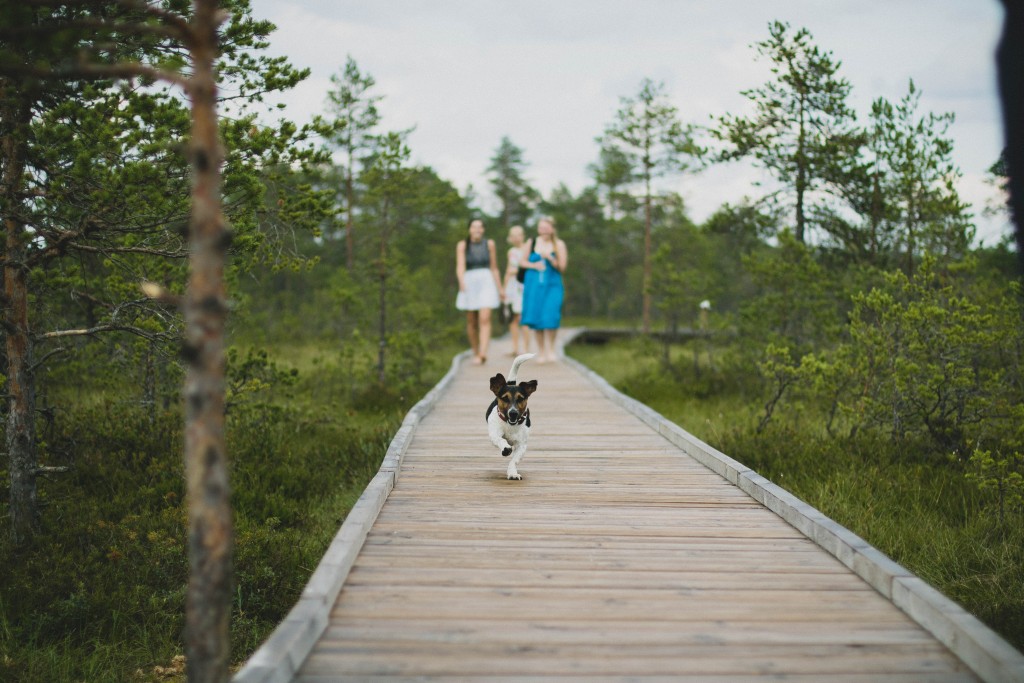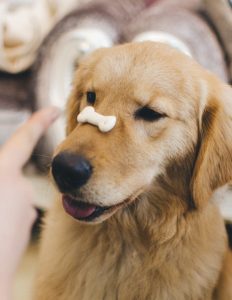Get an awesome recall. Join my 30 day, step by step program now...
Mastering “The Walk” with your Dog
Do you watch other dogs with envy and wish yours could walk beside you? If you do, you are not alone. In this blog I’m going to show you how to go about mastering the dog walk so you can both enjoy your walks together!
Many people tell me how jealous they are of other peoples dogs. How they wish theirs would walk to heel without pulling so hard they are actually choking themselves. Or how they wish he would come back when called, or at least not disappear into the distance when the lead is un-clipped. Sometimes, they just wish he could ignore other dogs and not jump all over every one he comes across!
Well the good news is that with a bit of work and patience, you too could have a calm dog, trotting beside you while everyone else in the park is wishing they were you!

Let’s walk together
A calm, attentive dog looks amazing as he danders along the forest path with his family. Walking together means you are a team, not leader or follower. Just two pals heading out into the world together. That alone is a good enough reason to work on your dogs behavior on the walk. But there are other reasons that I want to talk about before we get on with the “how to.”
First, lets talk about the calming effect walking with you can have on your dog. Slowing down the walk and adding some structure slows down the mind and can switch a reacting dog into a thinking dog. A thinking dog is much easier to walk. He considers his actions, and consults his pack before making decisions. This dog is listening; he is paying attention, and is in the right state of mind to learn new behaviors. This is a much better alternative to the half crazed dog that is jerking from one side to the other, sniffing everything, barking at everyone, and generally making a nuisance of himself.
Walking to heel also requires some self-control, and all dogs will benefit from mastering this. It will make a big difference to your walks, but also to his behavior in general. The discipline needed to walk to heel provides valuable mental stimulation. This is especially important to very smart dogs, but any dog will enjoy the challenge.
How can I help you with your dogs behaviour training?
Private Dog Behaviour Consultations are currently available online and in-person in Dundee and the surrounding area. If you are looking for help solving your dogs behaviour and training problems, please get in touch!
How much exercise?
Mastering the dog walk is not just about loose lead training and recall, it is important to get every aspect of it right. So we will start by making sure your dog is getting the right amount of exercise. If you get this right, it will have a massive impact on your success.
Every dog is different from the next, and I’m not just talking about their breed or mix of breeds. They all have different lifestyles, different foods, and different personal needs. So, it is very difficult to offer a definitive answer. But as a rule, every dog needs at least one good walk every day, but most would benefit from two.
The walk should consist of all six elements of a perfect walk (see below), and your dog should be tired at the end of it. After all this, if you are still struggling to solve training or behavioral problems, then it is a good bet that he still needs more physical or mental exercise.
Six key elements of the perfect dog walk!
There are six key elements you’ll need to incorporate if you are going to master the dog walk…
- Every dog benefits from the discipline of lead walking. I talked about that at the start, so I won’t go on about it too much other than to say that every walk should consist of some structured heel walking. At a minimum, he should get at least five minutes of calm, heel walking at the start and end of every walk. This sets the tone of the walk, and settles the mind and body.
- Free running is essential for every dog. It burns a lot of energy quickly, and really gets his heart racing. This is great for his mental and physical well-being. But if you are not confident your dog will come back to you when he is off the lead, don’t risk letting him off in public places. Instead, look out for dog parks that are fully enclosed. Your dog will be safe while he is playing and running, and in the mean time you can work to improve his recall.
- Investigating is very important to every dog. Dogs love to learn about the world they live in, and just one quick sniff, or taste, can tell him so much. He can learn about other dogs that share his space, ad discover new things for the first time. It’s mentally stimulating and can help build confidence. Don’t let him trail you down the street sniffing every leaf that moves though. Save it for off lead time, or take occasional breaks from heel walking to stop and sniff.
- Every walk should contain an element of play. Ideally this will be with other dogs, but if he’s not ready for that you’ll do. Play can also focus an easily distracted mind, and keep wandering dogs from disappearing into the distance.
- Meeting other dogs is vital for his emotional well-being. Spending time with his own kind is great for building confidence and it’ll keep his social skills topped up. Aim to meet one new dog every day. If he’s not ready for that yet, start working on his socialisation, it’s never too late to start again!
- Finally, every walk should include an element of problem solving. This is often forgotten about, but it can be achieved with a few rules. Try insisting your dog sits at every kerb, or before you take his lead off. Or maybe you could add a mini training session to his walks to sharpen up his skills. Perhaps a new game or toy could be introduced? He’ll use this part of his brain when he meets a new dog for the first time too!

The right tools for the job
Lets take a moment to talk about all the various different harnesses and leads that all promise to help you walk your dog more comfortably. There is no quick fix, however, some might work better for you than others. You might need to experiment a little before you find the one that will work best for you both. But I’ve listed a few of the most common types and their pro’s and con’s.
Head harnesses such as Halti’s, figure 8’s, or Gentle Leaders work by transferring control away from the neck and shoulders, which is where the dog is strongest. These harnesses work better on medium to large dogs, but can take a little time for the dog to get used to. With a little patience though, most dogs get the hang of them and they can make a huge difference to the way the dog feels on the lead. If you struggle to hold a strong dog, this might help you feel more in control.
No Pull Body Harnesses work by tightening around the dogs body when he pulls. This can unbalance him or make him feel strange, so for this reason they tend to work better on smaller dogs. The great thing about body harnesses is that almost all dogs readily accept them as they are very comfortable to wear. Larger dogs may find it easier to pull against them though. In just the same way a strong man uses a harness to help him pull a truck, a big dog can put his weight behind any harness and feel stronger!
Lead and collar
Most dogs have a collar and many are walked very successfully with just a lead and collar. If you are having trouble though, it may help to move the collar further up his neck so that it sits away from the shoulders. It will look weird but it will give you more control, and will reduce the strength of your dog. Always choose a standard clip or buckle collar. I don’t recommend choke, or half choke collars or any other type of collar that is designed to use pain as a deterrent to pulling.
You will also need a lead. You can get many fancy leads that do all kinds of things, but for this type of training I like to keep leads simple. A good quality rope or leather lead will serve you well for many years. You will be holding it quite short at the start, so choose something that is not too long, and that is comfortable for you to hold. I don’t recommend an extendable lead, unless you plan to keep it very short. Although, the comfy handle might be perfect if you find regular leads slip through your hand easily. A good pair of weight lifting or gardening gloves might also solve this problem though!
How to… Loose Lead Walking
Now down to the nitty gritty; the actual walk. When you are ready to start, bring your dog to your side; his shoulder should be in line with your leg. Now take up all the slack in the lead so that it is as short as it can go. It will feel tight, so let it out by an inch or so, just enough that it slackens slightly. Now just wait for your dog to stand still beside you. When he does you are ready to take your first step together.
Be prepared for him to shoot off and for the lead to tighten as soon as you move, this is normal. Just stop and wait for him to settle again. Once he is still again, take another step. Now just repeat, repeat, repeat.
If you are patient, he will soon realize that you go faster when he stays beside you. Don’t forget, he is used to walking with tension on the lead so this will take time. Be patient, and try not to worry if you don’t get very far the first few times. You’ve given him a problem to solve on his walk, so you can tick off element number 5. And, his brain will be tired, even if his body isn’t!
How to… Recall
There is no magic trick to learning the recall either. Just like the walk, it will just take patience and practice, oh and a bag full of yummy treats or your clicker!
Start in the garden; it is a safe place for your dog and will have less distractions. When he is just a few feet away, get a tasty treat ready. First, hold your hand in the air and call his name. Once you have his attention, bring the treat down to nose height, and give your command.
He should come to you straight away, that’s assuming he didn’t already come to you when he heard you getting his treat ready. As he comes, walk backwards a step or two to encourage him to come all the way. Then give him the treat and loads of praise, he did great. Practice this over and over in the garden, each time letting him get further and further away from you before you call him.
When he can do it easily in the garden, it’s time to find another safe place to practice. Consider a friends garden, or a secure dog park. Failing that, buy a long lead from the pet shop and use that to stop him running off while you continue to practice.
Practice this as much as you can and with as many different types of distractions, make it fun and he will have this mastered in no time.
If you need help with your recall, join my 30 Day Recall Programme!

Finally…
Now you know how to do it, you have some hard work to get on with, so here are a few final tips.
First, be patient and don’t put pressure on yourself to achieve too much. It will take time and patience to break habits.
Second, be consistent. This is very important, your dog will be confused if the rules change all the time.
What would you change about your dogs behaviour on the walk?
How can I help you with your dogs behaviour training?
Private Dog Behaviour Consultations are currently available online and in-person in Dundee and the surrounding area. If you are looking for help solving your dogs behaviour and training problems, please get in touch!
4 Comments
Leave a Reply
How can I help you with your dogs behaviour training?
Private Dog Behaviour Consultations are currently available online and in-person in Dundee and the surrounding area. If you are looking for help solving your dogs behaviour and training problems, please get in touch!



Great insights on mastering “The Walk” with your dog! It’s reassuring to know that with patience and the right techniques, even the most energetic dogs can become calm, attentive walking companions. The emphasis on structured walks, free running, and mental stimulation is key. I appreciate the practical tips and encouragement, especially for those struggling with pulling and recall. Looking forward to implementing these strategies and enjoying more harmonious walks with my dog!
Do you watch other dogs with envy and wish yours could walk beside you? You’re not alone! In this blog, I’m going to show you how to master the dog walk so you can both enjoy your walks together.
Walking with your dog as a team, not just as leader and follower, has numerous benefits. It promotes a calm mind, provides mental stimulation, and enhances your bond. Whether it’s structured heel walking or free running, each element plays a crucial role in creating enjoyable and beneficial walks for both of you. Start today, and soon you’ll be the one others envy in the park!
Mastering “The Walk” with your dog can transform your daily outings from stressful to enjoyable. It’s not uncommon to envy well-behaved dogs walking calmly beside their owners. Achieving this level of control and harmony requires patience and consistent training. Focus on loose-lead walking, heel commands, and recall techniques. Remember, every dog can learn to walk calmly, providing a more enjoyable experience for both you and your furry friend. Consistency is key!
Mastering “The Walk” with your dog takes patience and consistent effort. I found Caroline’s blog to be incredibly helpful, offering practical tips and detailed guidance. The six key elements she outlines for a perfect walk, including structured heel walking and free running, are game-changers. The advice on using the right tools, like head harnesses and body harnesses, ensures comfort and control. Thanks, Caroline, for these insightful tips to enhance our walking experience!